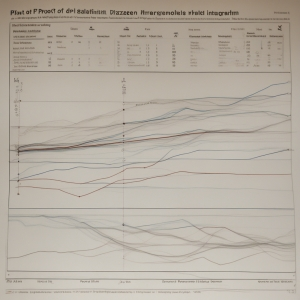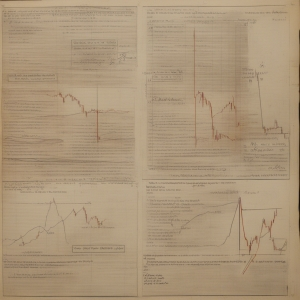If you are a novice in the cryptocurrency and financial field, the concept of trading can be a bit daunting initially. One of the techniques you might come across is known as Pivot Point Trading. This article aims to break down the concept for you so that you can navigate the financial market with more confidence.
Introduction to Pivot Point Trading
Pivot Point Trading is a frequently used method in the world of trading. It focuses on identifying key entry and exit points during trading. By identifying these 'pivot points', traders can anticipate the movement of the market and act accordingly. The pivot points serve as both an indicator of the market’s direction and a benchmark for traders.
The appeal of Pivot Point Trading lies in its simplicity and effectiveness. It presents a straightforward approach to gauge market trends. Also, it creates an opportunity to generate profitable trade possibilities. Regardless of which market you are in, be it stocks, commodities, Forex, or cryptocurrencies, pivot points can be a valuable addition to your trading stratagem.
In essence, mastering Pivot Point Trading can prove to be a powerful tool in your trading arsenal. It could help you improve your understanding of the market dynamics and consequently, the profitability of your trading endeavours. After all, knowledge is power, especially when it comes to financial decisions.
Understanding Pivot Points
Pivot points are mathematical calculations used to determine potential support and resistance levels in trading. These calculations are based on the high, low, and closing prices of the previous trading period. In essence, pivot points serve as the critical junctions where significant price movements can take place.
There are several types of pivot points, the most common being the Standard, Fibonacci, and DeMark pivot points. Each of these has its mathematical basis, but they all aim to predict price movements and assist traders in making informed trading decisions.
An understanding of how to calculate and interpret pivot points is essential in pivot point trading. The more you understand about these key elements, the more you'll be able to capitalize on the market trends, and make calculated bids that yield substantial profits.
Pros & Cons of Trading Pivots
| Pro | Con |
|---|---|
| Accurately identifies key support and resistance levels | May not factor in upcoming news and events |
| Can predict potential pivot points ahead of time | Not all pivot points may lead to significant price changes |
| Can be used for both long and short term analysis | May require a considerable amount of data for accurate results |
| Effective in ranging and sideways markets | Can be misleading in strongly trending markets |
Applying Pivot Points in Trading

Once you comprehend the concept of pivot points, the question becomes: how do you apply them effectively in your trading decisions? First things first, choose the type of pivot point system that best fits your trading strategy. Having done so, the next step would be to plot these points on your trading charts.
In any given trading day, the calculated pivot point from the prior day’s data serves as the primary support or resistance level. When the current price is below the pivot point, sellers are generally perceived to have the upper hand. Conversely, when the current price is above the pivot point, buyers are assumed to be in control. Thus, pivot points can help traders foresee potential price reversals and take advantage of profitable opportunities.
In essence, a pivot point acts as a compass, helping you navigate the financial market more effectively. It puts you in a position to anticipate movements, rather than merely reacting to them. This is especially true when the market is experiencing high volatility. Instead of getting caught in the whirlwinds of uncertainty that come with fast-paced market changes, the pivot point system can provide a semblance of stability. It provides a clear snapshot of the market’s potential trajectory even amidst volatility.
While pivot point trading yields fascinating insights, it's prudent to remember that to predict market movement accurately, no single tool should be used in isolation; multiple trading indicators should be part of your toolkit.
Examples of Pivot Point Trading
Now that we have the essential knowledge about pivot points, let's look at some examples of how Pivot Point Trading might work in practical scenarios.
For instance, consider a cryptocurrency whose previous day experienced a high of $250, a low of $200, and a close at $220. The pivot point would be calculated as follows:
[(High + Low + Close) / 3]
This gives us a Pivot Point of around $223.33. This level, hence, becomes the critical reference for the next day of trading. If the price opens above this level, it could suggest a bullish market trend, thus signalling potential buying opportunities. Conversely, if the price opens below the pivot point, it could indicate a bearish market, possibly presenting chances to sell.
Remember, it's not enough to use pivot points in isolation. Combining them with other technical analysis tools — such as trends, chart patterns, and other indicators — can produce a more effective trading strategy.
Additionally, do note that pivot points are one of the "leading" indicators. They anticipate future price movements, and hence, while they offer fantastic insights, they come with their inherent uncertainties and should not be the sole determinant of your trading decisions. Successful trading involves striking a balance between various tools and strategies.
Conclusion

Engaging with the financial market can be a challenging endeavour, especially for novices. Concepts like Pivot Point Trading can seem complex at first glance, but understanding and gaining mastery of them can significantly enhance your trading proficiency and financial educations.
Pivot Point Trading offers a practical, straightforward technique to gauge market trends and identify critical entry and exit points. Getting to grips with this concept can be a significant step towards effectively navigating the financial market. Remember, however, that no single tool can accurately predict market behaviour all the time, and balance with other strategies and tools is key.
Advantages and Disadvantages of Pivot Point Trading
In every trading strategy, understanding the strengths and weaknesses is essential for success. Let's examine the upsides and the limitations inherent to Pivot Point Trading:
Advantages:
- Simple to understand: Pivot Point Trading is arguably one of the more clear-cut techniques to comprehend. The mathematical formula is straightforward and easy to interpret.
- Applicable to multiple markets: It can be utilized across various trading markets, be it cryptocurrencies, commodities, stocks, or forex.
- Predictive, not lagging: As opposed to some trading indicators that rely heavily on past data, pivot points are inherently predictive, providing potential future turning points in the market.
Disadvantages:
- Inaccuracy in volatile markets: At times of high market volatility, pivot point calculations may not provide the most accurate predictions.
- Dependent on Period Settings: The reliability of pivot points relies significantly on the period settings selected, which could detract from their effectiveness if not properly defined.
- Best in conjunction with other tools: Pivot points on their own don't always tell the full story. They are most effective when used along with other technical indicators.
In conclusion, while pivot point trading offers several advantages, traders must also be wary of its limitations. As with any strategy, success often lies in the trader's ability to effectively combine tools and techniques to enhance their risk management and maximise their potential profits.
Conclusion: The Role of Pivot Points in Trading

In the fluctuating world of trading, Pivot Point Trading can be a game-changer. By identifying key points of action in the market, this simple yet profound technique can assist you in making better informed financial decisions. Capitalizing on pivot points can help you transform your approach from reactive to proactive, giving you a competitive edge in the market.
However, it is critical to understand that pivot points are not infallible. They should be utilized in combination with other trading indicators to form a cohesive and robust trading strategy. No tool works best in isolation; purist approaches often fall short in a field as unpredictable as trading.
Overall, Pivot Points represent an accessible entry point into understanding the market's ins-and-outs. They can become a solid foundation upon which to build your trading competence. By gaining mastery over these points, you can confidently step into the financial market with a substantial trading tool in your arsenal.
As you venture into the world of trading, remember, persistence and continuous learning make the best traders!
Essential Guide on Trading Pivot Points
What are pivot points in trading?
Pivot points in trading are indicators used by traders to determine potential points where the currency price has a high probability of reversal. They are calculated using the open, high, low, and close from the previous trading day.
How to calculate pivot points?
Pivot Point (P) = (High + Low + Close)/3. Support and resistance levels are then derived from the pivot point.
How are pivot points used in trading?
Pivot points can be used as an indicator for predicting market movement. A move above the pivot point may imply bullish sentiment, while a move below the pivot point may imply bearish sentiment.
What types of pivot points are there?
The types of pivot points include Standard Pivots, Fibonacci Pivots, DeMark Pivots, and Camarilla Pivots.
What are the limitations of pivot points?
Pivot points are purely a mathematical calculation, they don't consider factors such as market sentiment, political or financial news which may impact the price movements.







